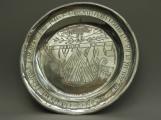14
Another piece given at that time, a large and ornate Kiddush cup used for blessing the wine on Shabbat, also has a connection to Josef's hometown. The Arons had acquired the cup from the collection of Rabbi Samson Raphael Hirsch, who was the rabbi of Frankfurt am Main from 1851 until his death in 1888 and was one of the primary leaders of Orthodox Jewry in nineteenth-century Germany. It is possible that this cup was originally part of Paul Aron's collection in Frankfurt and that it was given to Josef as a gift during one of his visits to Jerusalem.
15
Pidyon Haben Tray (Silver) Early 20th century
Date not available
Poland

16
The remaining three pieces were acquired by Josef and Anna through Sam Borenstein, an artist who married Josef's niece, Judith. In addition to working as a painter, Sam bought and sold paintings and antiques. He always looked out for interesting items of Judaica for his wife's uncle.
17
Judith and Sam Borenstein
1947

18
Sam Borenstein's daughter, Joyce Borenstein, remembers looking at the antiques acquired by her father: "Everyday he came home with either a fabulous rug, or some new art books, or some Jewish silver. He would always come home with something special."
19
Pidyon Haben Tray (Silver) Early 20th century
Date not available
Poland

20
The two silver Pidyon Haben plates acquired through Sam Borenstein originally came from Poland. They were purchased by an antique dealer in Germany after World War II and brought to Montreal to be sold. The two plates are part of a matching set, or were perhaps once a part of a larger series. The decoration on the outer edge of each plate is identical. The plates were intended for use during the Pidyon Haben ceremony, when the parents of a first-born son redeem their child on the thirty-first day of his life through a ceremony that is meant to fulfill a Biblical command. It is likely that the two trays were used either for presenting the sum of money for the redemption or solely for decorative purposes.
21
Seder Plate (Pewter)
1770
Germany

22
A silver seder plate, to be used during the ceremonial Passover meal, was also acquired through Sam Borenstein and donated at that time. The seder plate was made in Germany in the year 1770.
23
Josef and Anna Aron were deeply committed to the museum and looked forward to seeing the collection grow. They hoped that their initial donation would encourage others to do likewise. Members of the Temple's congregation were encouraged to offer gifts to the museum in order to celebrate special events or to memorialize loved ones.
24
Kiddush Cup (Silver)
1897
Frankfurt, Germany

25
Josef was fortunate enough to witness the museum's birth and initial growth, but he passed away in 1956, only three years after the museum's opening. Anna Aron donated a Kiddush cup to the museum in memory of her husband. The large and elaborately decorated cup, used for the blessing over the wine on Shabbat, was made in Josef's hometown of Frankfurt am Main, Germany in 1897. Many members of the Temple Emanu-El community gave gifts in memory of the museum's founder at that time.
26
Torah Pointer 19th century
Date not available
Central Europe

27
Reuben Ginsberg, Anna Aron's brother, and his wife Betty donated a Torah pointer in memory of their brother-in-law. The Torah pointer, also known in Hebrew as a "yad," is used while reading the Torah to help follow the script.